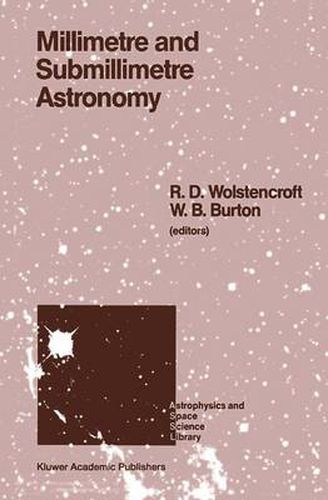Readings Newsletter
Become a Readings Member to make your shopping experience even easier.
Sign in or sign up for free!
You’re not far away from qualifying for FREE standard shipping within Australia
You’ve qualified for FREE standard shipping within Australia
The cart is loading…






This title is printed to order. This book may have been self-published. If so, we cannot guarantee the quality of the content. In the main most books will have gone through the editing process however some may not. We therefore suggest that you be aware of this before ordering this book. If in doubt check either the author or publisher’s details as we are unable to accept any returns unless they are faulty. Please contact us if you have any questions.
The millimetre and submillimetre spectral region (300 to 3000 Ilm or 1000 to 100 GHz) was until recently one of the few spectral regimes not fully opened up for astronomical studies. Thanks both to improvements in detectors and receivers and to the construction of large telescopes at high altitude sites this situation is improving very rapidly. Three major telescopes have been built recently and are coming into operation during 1987 and 1988, namely the 15m James Clerk Maxwell Telescope (JCMT) and the lOAm Caltech Submillimetre Observatory (CSO) telescope, both located on Mauna Kea, Hawaii, and the 15 m Swedish -ESO telescope (SEST) in Chile. Because a very wide range of astronomical problems can be tackled with these major new facilities there is a great deal of interest from the many potential new users anxious to become familiar with this rapidly developing field. During 1986 it became clear to British and Dutch astronomers involved in planning the commissioning and operation of the JCMT, that a summer school in this field would greatly benefit the potential and actual JCMT user community. With financial support from the SERC and supplemented by a grant from the ZWO, the Summer School on ‘Millimetre and Submillimetre Astronomy’ was held at Stirling University from June 21 to 27, 1987.
$9.00 standard shipping within Australia
FREE standard shipping within Australia for orders over $100.00
Express & International shipping calculated at checkout
This title is printed to order. This book may have been self-published. If so, we cannot guarantee the quality of the content. In the main most books will have gone through the editing process however some may not. We therefore suggest that you be aware of this before ordering this book. If in doubt check either the author or publisher’s details as we are unable to accept any returns unless they are faulty. Please contact us if you have any questions.
The millimetre and submillimetre spectral region (300 to 3000 Ilm or 1000 to 100 GHz) was until recently one of the few spectral regimes not fully opened up for astronomical studies. Thanks both to improvements in detectors and receivers and to the construction of large telescopes at high altitude sites this situation is improving very rapidly. Three major telescopes have been built recently and are coming into operation during 1987 and 1988, namely the 15m James Clerk Maxwell Telescope (JCMT) and the lOAm Caltech Submillimetre Observatory (CSO) telescope, both located on Mauna Kea, Hawaii, and the 15 m Swedish -ESO telescope (SEST) in Chile. Because a very wide range of astronomical problems can be tackled with these major new facilities there is a great deal of interest from the many potential new users anxious to become familiar with this rapidly developing field. During 1986 it became clear to British and Dutch astronomers involved in planning the commissioning and operation of the JCMT, that a summer school in this field would greatly benefit the potential and actual JCMT user community. With financial support from the SERC and supplemented by a grant from the ZWO, the Summer School on ‘Millimetre and Submillimetre Astronomy’ was held at Stirling University from June 21 to 27, 1987.